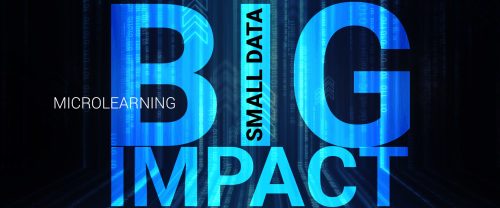E-learning has been around for a long time now to make it an established channel of training and education. It supplements traditional methods of education along with being a great tool for training on-the-job. It does however face the challenge of having to deliver a hefty syllabus. With the motivation to complete these courses being very low, dropout rates are high. This not only defeats the purpose of these platforms but also wastes the resources that have been invested to build it. Experts in the field of e-learning have been able to counter this problem with micro-learning.
Micro-learning is a highly focused method of e-learning which emphasizes on concepts or ideas by delivering them in bite sized learning nuggets. Although micro-learning is not a new concept (flash cards being a traditional example), it has certainly been reinvented by making it go digital. With micro-learning, information can be delivered not just via text but also through video, audio, interactive games, infographics and such. A highly mobile form of learning, it is smartphone compatible. Our short attention span seems to have made micro-learning all the more relevant.
MICROLEARNING: AN AGILE WAY OF LEARNING

E-learning has been around for a long time now to make it an established channel of training and education. It supplements traditional methods of education along with being a great tool for training on-the-job. It does however face the challenge of having to deliver a hefty syllabus. With the motivation to complete these courses being very low, dropout rates are high. This not only defeats the purpose of these platforms but also wastes the resources that have been invested to build it. Experts in the field of e-learning have been able to counter this problem with micro-learning.
Micro-learning is a highly focused method of e-learning which emphasizes on concepts or ideas by delivering them in bite sized learning nuggets. Although micro-learning is not a new concept (flash cards being a traditional example), it has certainly been reinvented by making it go digital. With micro-learning, information can be delivered not just via text but also through video, audio, interactive games, infographics and such. A highly mobile form of learning, it is smartphone compatible. Our short attention span seems to have made micro-learning all the more relevant.
Features of micro-learning
Short
The information that is to be disseminated is bite sized and concise. Superfluous and redundant information is done away with and only the central thought is communicated. Usually, the time-frame is about 3 to 5 minutes.
Precise
Each nugget focuses on a specific idea. This ensures maximum impact. If required, this nugget may be broken down into micro-nuggets.
Flexible
Micro-learning works well with a variety of channels – text, audio, video, gaming etc. The channel is chosen as per its suitability. The multi-sensory experience of micro-learning sets it apart from traditional e-learning.
Smartphone compatible
Banking on our short attention span and the mobility of smartphones, micro-learning has grown in leaps and bounds. With an almost Instagram-like user experience, micro-learning is best suited for people on the move.
Low maintenance
Micro-learning courses can be created with the use of basic tools. That makes updating and maintaining it quite easy.
Just-in-time learning
Micro-learning helps to close knowledge or skills gaps fairly quickly. The learner usually doesn’t need to have any prior knowledge of the subject.
Benefits of micro-learning
Better retention
Since the content delivered is bite sized, it is easier to stay focused. With attention rates falling rapidly every year, more and more agencies are embracing micro-learning.
Higher completion rates
Since the learner is not overwhelmed with information and learning is paced, micro-learning has seen higher completion rates. Most micro-learning courses are flexible enough to be accessed on the go. This only adds to its completion rates.
Easier to create
Most micro-learning courses don’t require extensive research. They are highly focused and the information is condensed to provide content on a need-to-know basis. This makes the content easier to create and consume.
Economical
The cost of creating micro-learning courses is much lower than creating extensive and bulky courses. Moreover, the return on investment is much higher as it is much more result-oriented than the traditional form of learning.
Quick & easy
Learners can spend as little as 20 minutes a week to master skills or concepts via micro-learning. Since it is easier to retain short bursts of information, learners feel encouraged to progress faster through the course.
Highly engaging
Micro-learning gives space to developers to innovate and find better ways of learning. Since the focus is on short bursts of information, learning is more casual, making it entertaining and engaging rather than dry and academic.
Applications of micro-learning
Business
Training and development in business is ever growing with rapid changes in systems. Micro-learning can be easily adapted to close knowledge and skill gaps to keep up with the work dynamics of the industries. Onboarding and compliance training are just two common applications of micro-learning.
Education
Education is no longer bound by traditional methods of learning. Concepts are understood easily if they are broken down into nuggets. Micro-learning is the learning aid that can up retention rates, especially when it comes to content that has to be memorized.
While it cannot fully replace traditional form of learning and training, at its best, micro-learning provides an immersive learning experience. One that is entertaining, engaging and easily consumable by learners. If the pitfalls are navigated carefully, micro-learning proves to be lifesaver if you’re drowning in a sea of information.
Learn about the various digital learning solutions that we can offer. Custom Content Learning
You must be logged in to post a comment.









